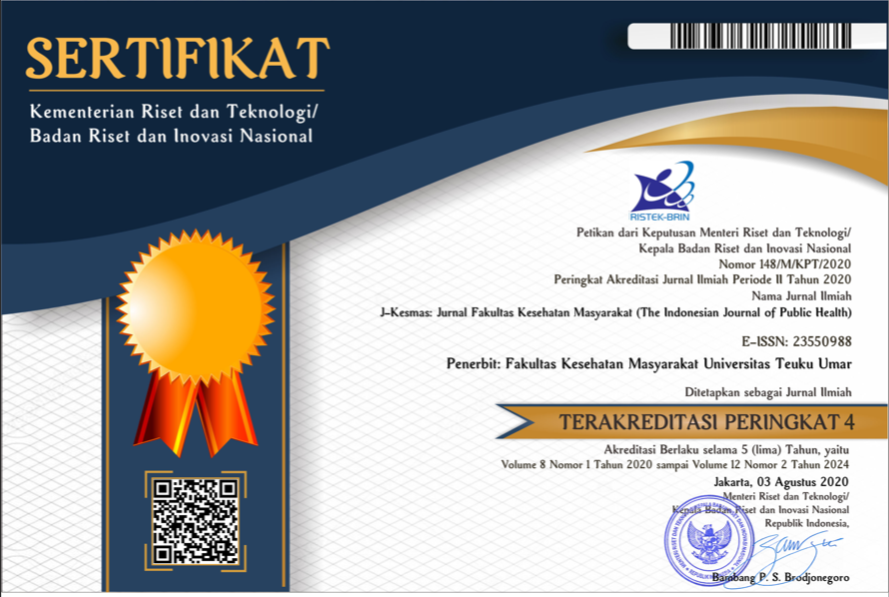Relationship Between Health Literacy and Re-emerging Elephantiasis in Aceh Barat
Abstract
Filariasis is an infectious disease caused by filarial worms if it is not fast, it will experience permanent disability, it occurs when a chronic condition occurs when the feet and hands become swollen, in that condition it is called elephantiasis (elephant leg). West Aceh Regency is one of the districts which has the highest number of filariasis cases, which continues to increase from 9 cases in 2015 to 15 cases in 2017. Many factors are suspected to be the cause of elephantiasis including knowledge, behavior, physical home environment, socialization of counseling to health workers. health literacy with the re-emergence of elephantiasis in West Aceh Regency in 2019. This study used a quantitative study to determine the risk of elephantiasis using Matched Case Control. The population of cases in this study were people who suffered from elephantiasis in the district of West Aceh. Given the population (N), namely patients with filariasis <100, the sample in this study was the total population using a ratio of 1: 3, so the number of samples in this study was 60 people consisting of 15 cases and 45 people as controls. The results showed that the disease re-emerged. Elephantiasis in West Aceh Regency in 2018 was related to health literacy (p = 0.003)
Full Text:
PDFReferences
Amalia, I. S. & Annashr, N. N. 2018. Faktor Sosiodemografi Dan Perilaku Yang Berhubungan Dengan Kejadian Filariasis Di Kabupaten Kuningan. Jurnal Kampus Stikes Ypib Majalengka, 6, 1-19.
Amelia, R. 2014. Analisis Faktor Risiko Kejadian Penyakit Filariasis. Unnes Journal Of Public Health, 3.
Irfan, I., Kambuno, N. T. & Israfil, I. 2018. Factors Affecting The Incidence Of Filariasis In Welamosa Village Ende District East Nusa Tenggara. Global Medical & Health Communication, 6, 130-137.
Kemenkes, R. 2015. Peraturan Menteri Kesehatan Republik Indonesia Nomor 94 Tahun 2014 Tentang Penanggulangan Filariasis. Jakarta: Kementerian Kesehatan Republik Indonesia, 1-118.
Kementerian Kesehatan, R. 2010. Rencana Nasional Program Akselerasi Eliminasi Filariasis Di Indonesia 2010-2014. Subdit Filariasis Dan Schistomiasis Direktorat P2b2, Ditjen Pp Dan Pl. Kemenkes Ri.
Komaria, R. H., Faisya, F. & Sunarsih, E. 2016. Analysis Of Physical Environment And Preventive Behavior Determinants Toward Genesis Filariasis Cases In The Sub-District Of Talang Kelapa And Sembawa, District Of Banyuasin. Jurnal Ilmu Kesehatan Masyarakat, 7, 108-117.
Lapau, B. 2009. Prinsip Dan Metode Epidemiologi, Jakarta, Fk.Ui.
Ottesen, E. A. 2000. The Global Programme To Eliminate Lymphatic Filariasis. Tropical Medicine & International Health, 5, 591-594.
Widawati, M., Riandi, M. U. & Yuliasih, Y. 2019. Pengetahuan Filariasis Dan Penggunaan Obat Gosok Pengusir Nyamuk Di Wilayah Endemis Filariasis. Jurnal Ekologi Kesehatan, 18, 80-87.
DOI: https://doi.org/10.35308/j-kesmas.v8i1.3297
Refbacks
- There are currently no refbacks.
Managed by Fakultas Kesehatan Masyarakat
Published by Universitas Teuku Umar
Website: http://jurnal.utu.ac.id/jkesmas
Email: jkemas@utu.ac.id 
This work is licensed under a Creative Commons Attribution-ShareAlike 4.0 International License.







.jpg)


